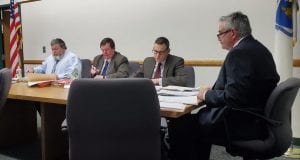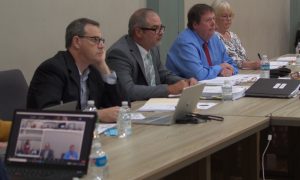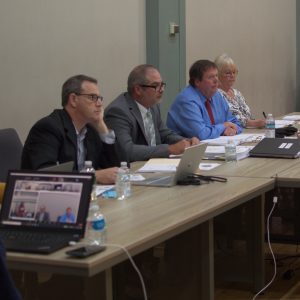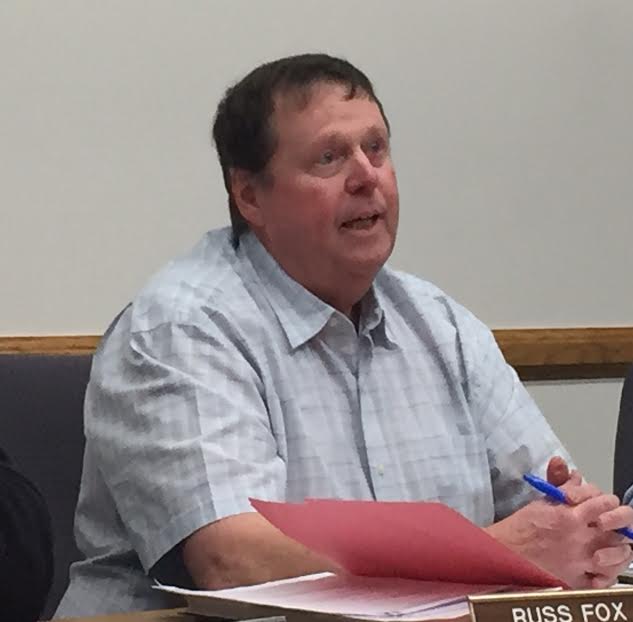
Selectmen Joseph Deedy, Russell Fox, Douglas Moglin, and Chief Administrative Officer Karl Stinehart discuss Congamond Lake treatment Jan. 28, 2020. (Photo by Peter Currier)
SOUTHWICK- The planned aluminum sulfate treatment for Congamond Lake will be open for bids Feb. 25 and a special town meeting on the matter is being planned for late March.
Chief Administrative Officer Karl J. Stinehart said during the Jan. 28 Select Board meeting that the treatment of the lake should take place in April if everything goes according to plans.
Select Board Chair Russ Fox said that he would like further discussion on the funding mechanisms of the treatment. He noted that he had spoken with state Rep. Nicholas Boldyga, who sent out a letter to the administration of Gov. Charlie D. Baker on Tuesday.
“That’s the board’s commitment to try to secure additional resources through the state to compliment what we are going to be doing through the Community Preservation Committee,” said Stinehart.
Fox noted the importance of a more permanent treatment of the lake, citing that a lack of treatment could have an effect on local water supplies.
“Hopefully people realize that these are great lakes and are the responsibility of the Commonwealth of Massachusetts, and it also could affect the water supply of not only Southwick, but also of West Springfield and Westfield,” said Fox.
The Aluminum Sulfate treatment, or “alum” treatment, is necessary this year due to the presence of cyanobacteria caused by algae blooms in Lake Congamond. North Pond had tested negative for the contamination but Middle and South Ponds were both given a more temporary copper sulfate treatment in recent years. Congamond Lake is comprised of the three ponds.
Michelle Pratt of Citizens Restoring Congamond and Dick Grannells of the Lake Commission said that an aluminum sulfate treatment will be necessary, or the lake risks being closed next summer and onwards.
“Over recent years, the algae has been treated with copper sulfate, but that is just a band-aid approach,” said Pratt in December, “You can only do that so many times, and we have used two-and-a-half tons of it recently.”
The alum treatment is supposed to keep the lake free of cyanobacteria-causing algae for 15 to 20 years, a far longer period of time than is possible with the copper sulfate treatment.
Pratt noted that, much like antibiotics in humans and animals, too much copper sulfate treatment of the lake could cause copper sulfate-resistant strains of algae and cyanobacteria. The alum treatment would not have that problem due to the long periods of time between treatments.
Should the lake somehow go untreated before the summer, it may be closed if more than 70,000 cells of cyanobacteria are detected in a milliliter of lake water.
The current theory for the recent algae blooms in Lake Congamond and other local bodies of water is a combination of the sheer age of the lake and human activity. Congamond Lake is approximately 14,000 years old, which allows for large accumulations of muck and decaying plant matter at the bed of the lake.
Most of the Congamond shoreline is lined with homes and businesses. Fertilizer runoff, detergents, and other human wastes has accelerated the conditions necessary for the algae to thrive during warmer weather.
Another factor, which will likely be addressed in conjunction with the alum treatment, is that the lake only had two outlets for the water and those outlets have become clogged with muck and fallen branches. This impedes that water’s ability to filter out of the lake.
Dredging projects may be necessary to clear those blockages and allow the water to filter out.







